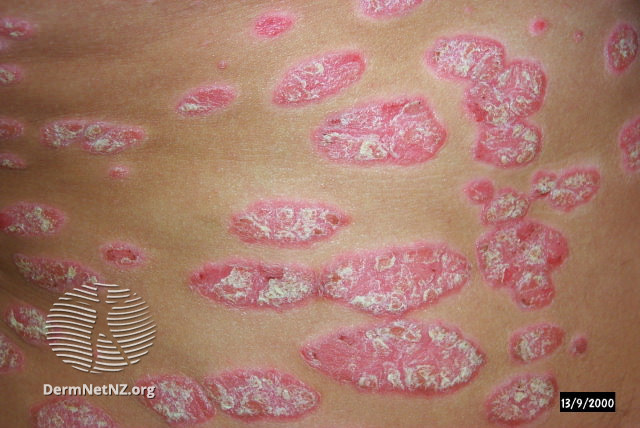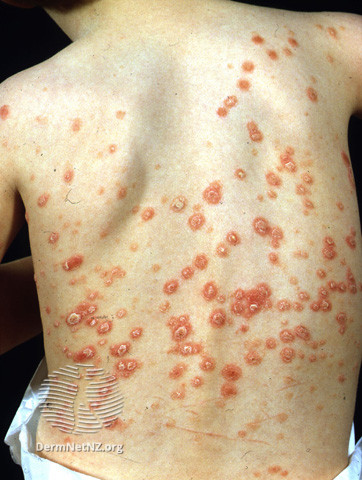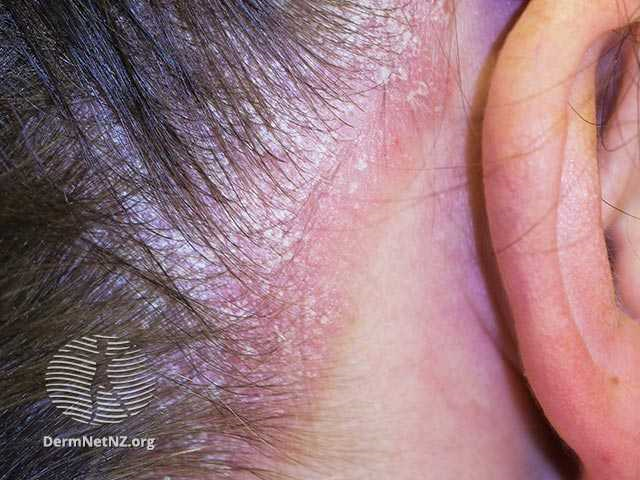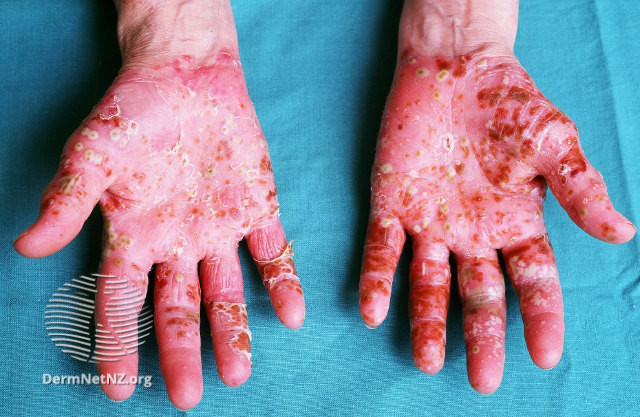Psoriasis is a common, autoinflammatory disease of the skin that affects around 2% of the UK population. The majority of patients can be managed in Primary Care.
Some patients, particularly those with longstanding or severe disease, will be prone to comorbidities including psoriatic arthritis, increased risk of cardiovascular disease and depression. Psoriasis can have a significant psychological impact, independent of disease severity. Although psoriasis can present at any age, most patients develop the condition between 15 and 35 years of age, with a smaller peak in incidence in the elderly. The cause of psoriasis is unknown. Only about half of patients have a family history of psoriasis, and the genetics are complex.
For most patients, a trigger for the development of psoriasis will not be identified, but some co-factors include stress, medication (particularly lithium and hydroxychloroquine) and streptococcal infection.
There are several different morphological types of psoriasis.
Chronic Plaque Psoriasis
- Localised stable plaques on extensor aspects with characteristic scale


Guttate Psoriasis
- Acute onset of numerous small scaly lesions-sometimes after a streptococcal throat infection.
- Usually self-limiting within three to six months
- May go on to develop chronic plaque psoriasis particularly if family history.
Scalp Psoriasis

- Scaly localised or diffuse plaques extending to scalp margin, particularly behind the ears.

May be associated with temporary thinning of scalp hair

Flexural Psoriasis
- Smooth, shiny well demarcated areas in body folds or genital area – may be mistaken for fungal infection.
- May occur without psoriasis elsewhere
- Remember to ask patients with evidence psoriasis about genital involvement as they may not volunteer this.
image from Search DermNet | DermNet (dermnetnz.org)
Facial Psoriasis
- Less common, but high impact subtype.
- Well demarcated red plaques may occur.
- There may be overlap with features of seborrhoeic dermatitis – a condition called “sebo-psoriasis”.

Nail Psoriasis
- Changes include pitting, onycholysis (separation of nail from bed with yellow discolouration) and oil/ salmon patches where translucent pink patches seen under nail bed.
- May be mistaken for fungal nail infection although samples for mycology should be taken if diagnostic doubt (see Common Nail Disorders page). It is not unusual to find fungus in psoriatic nails.
Palmoplantar pustulosis

- More common in females and smokers (though quitting does not improve skin).
- Yellow pustules and erythema on palms and soles which then become brown.
- Around a quarter of patients have a history of chronic plaque psoriasis.
Generalised erythrodermic/pustular psoriasis
- Erythroderma = at least 90% body surface area involved
Rare – red tender skin with widespread pustules. - Patients often systemically unwell.
- May be precipitated by withdrawal of potent topical or oral steroids.
All images on this page are sourced from DermNet | Dermatology Resource (dermnetnz.org)
R.C 24-05-24
Dermatology Referral Criteria
- Emergency referral is indicated for generalised erythrodermic or generalised pustular psoriasis – discuss with on-call registrar.
- Extensive / severe / recalcitrant disease requiring phototherapy or systemic therapy
- Diagnostic uncertainty
- Involvement of sites which are difficult to treat, e.g. the face, palms and genitalia that have not responded to appropriate treatment.
- Failure of appropriate topical treatment after 2 or 3 months’ use
- Refer to Rheumatology if any symptoms suggestive of psoriatic arthropathy. Painful swelling of the distal interphalangeal joints, asymmetric large joints (hips/knees), spondylitis and a polyarthritis picture may all be presentations of psoriatic arthropathy and early referral reduces risk of joint destruction.
Assess lifestyle factors which may precipitate or aggravate psoriasis i.e. smoking, alcohol, certain medications and infections.
Severe psoriasis is associated with increased risk of cardiovascular disease. Advise healthy lifestyle and consider annual CVD risk assessment and fasting glucose, particularly for those with additional risk factors.
Chronic plaque psoriasis
- Emollient and soap substitute – reinforce need for liberal and frequent use.
- Vitamin D analogue +/- moderately potent or potent topical steroid. Calcitriol (found in Dovonex) or calcipitriol, which may be less irritant (found in Silkis) can be used long term alone, but adding in a potent topical steroid for up to 4 weeks may achieve more rapid control of symptoms, particularly where there is active inflammation.
- The LJF recommends using individual preparations though combined preparations such as Dovobet and Enstilar can be used “where adherence is an issue”.
- Review after 4 weeks and consider switching to Vitamin D analogue alone for longer term treatment.
- Coal tar preparations (see LJF). Warn patient may stain hair, skin and clothes.
- Dithranol cream as short contact therapy- apply carefully to lesions at concentrations of 0.1%–2%, usually for short contact periods of 30–60 minutes. It stains skin, clothing, baths and floors
Guttate psoriasis
- Emollient and soap substitute
- Vitamin D analogue. Can be difficult to apply to individual lesions so may be better to use coal tar lotion.
- Moderate potency (eg clobetasone buytrate) topical steroid for symptomatic patients.
- Coal tar preparations (see LJF)
- Consider referral for phototherapy (narrow band UVB) if not settling with treatment.
Scalp psoriasis
Step 1: soften and remove scale using
- Oil or keratolytic e.g. coconut, tar and salicylic ointment (eg Sebco/Cocois). Apply anything between an hour or overnight depending on severity & compliance. Wash off after use.
- Can be used daily for a week to remove stubborn scale and as required thereafter.
- Tar based shampoo (see LJF – be aware Polytar contains peanut oil)
Step 2: Active treatment (once scale removed)
- Vitamin D analogue + / – potent topical steroid (mousse, gel and lotions available
Step 3: Maintenance
- Tar based/coconut oil shampoos such as Polytar/Neutrogena T-gel or Capasal can be used 2-3 times per week to reduce risk of flare. These named products are on LJF
Some patients struggle with complex topical regminens, Consider a single agent topical steroid lotion if concordance is a concern.
Flexural psoriasis
- Mild to moderate potency steroid. Combine with antibiotic/antifungals if secondary infection thought to be present.
- Vitamin D analogue with care (calcitriol possibly less irritant).
- Calcineurin phosphatase inhibitors (pimecrolimus/tacrolimus) may be used on the advice of a specialist.
Facial psoriasis
- Emollients
- Mild/moderate potency topical steroid +/- antifungal.
- Vitamin D analogues
- Pimecrolimus cream or tacrolimus ointment can work well but is off label and should only be initiated on specialist advice
Palmoplantar pustulosis
- Can be difficult to manage effectively with topical therapy alone.
- Potent or very potent topical steroid under occlusion may help.
For Patients
https://www.psoriasis-association.org.uk/
PIL – https://www.bad.org.uk/pils/psoriasis-an-overview/
For Health Professionals
Link to PCDS psoriasis-an-overview guidance
SIGN Summary https://www.sign.ac.uk/assets/qrg121.pdf













